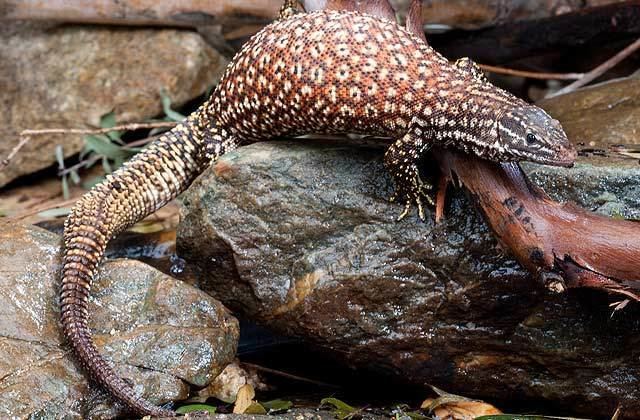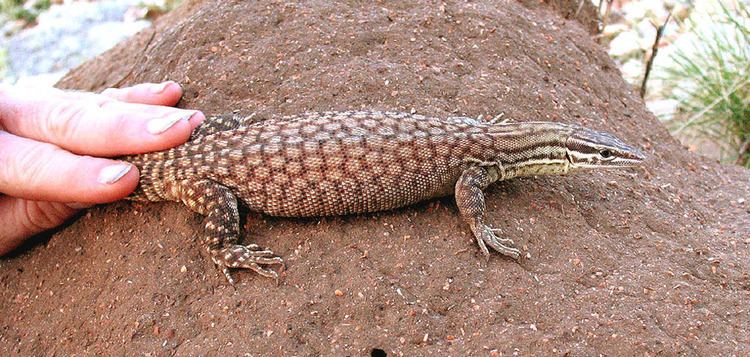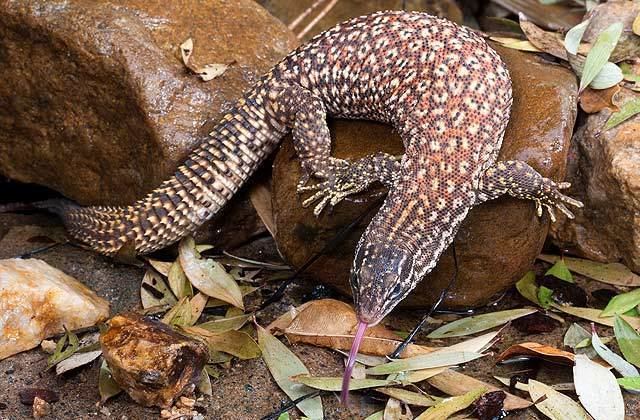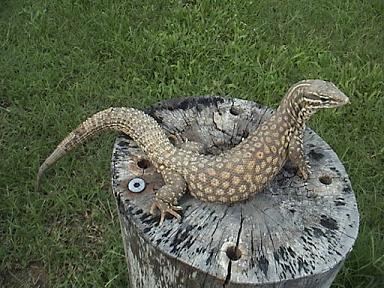Genus Varanus Scientific name Varanus acanthurus Rank Species | Phylum Chordata Family Varanidae Subgenus Odatria | |
 | ||
Similar Monitor lizard, Reptile, Emerald tree monitor, Black‑headed monitor, Kimberley rock monitor | ||
The spiny-tailed monitor (Varanus acanthurus), also known as the ridge-tailed monitor or Ackies dwarf monitor, is an Australian species of lizard belonging to the genus of monitor lizards (Varanus).
Contents

Description

The spiny-tailed monitor, a medium-sized monitor lizard, can attain a total length of up to 70 cm (27 inches). The tail is about 1.3-2.3 times longer than head and body. The upper side is a rich, dark brown and painted with bright-yellowish to cream spots, which often enclose a few dark scales. Its tail is round in section and features very spinose scales. There are 70-115 scales around the middle of the body. The spiny-tailed monitor is distinguished from the similar-looking species V. baritji and V. primordius by the presence of pale longitudinal stripes on the neck.
Distribution and habitat

This arid-adapted lizard is found in northern Western Australia, in the Northern Territory and in the eastern and northeastern parts of Queensland. The spiny-tailed monitor inhabits is associated with arid rocky ranges and outcrops.it is still a all
Subspecies and taxonomy
The spiny-tailed monitor is part of an exclusively Australian radiation of small monitor lizards, the subgenus Odatria.

In the past, three subspecies of V. acanthurus were recognised: The continental subspecies V. a. acanthurus and V. a. brachyurus, and V. insulanicus, that only inhabits Groote Eylandt and the islands of the Wessel group. In 2006, the results of a study on the mtDNA of Australian monitors were published, according to which the two continental subspecies do not form natural (monophyletic), taxonomic entities. V. a. insulanicus was proven to be monophyletic, but it is more closely related to V. baritji than to other V. acanthurus. Therefore, V. a. insulanicus might represent a distinct species. Wilson and Swan (2010) still accept V. a. insulanicus as a valid subspecies of V. acanthurus, which is easily distinguished from other spiny-tailed monitors by its dark colouration and more-banded pattern.
Ecology
Spiny-tailed monitors are diurnal, solitary ground-dwellers. This species is most often found in its shelter, mainly under rock slabs, boulders or in rock crevices. Only rarely do they hide in spinifex. As the spiny-tailed monitor has a lower level of activity compared to other monitor lizards, as well as a lower metabolic rate, it is often found in its hideout at day, and most likely it is a sit-and-wait-predator. They prey mainly on insects, especially orthopterans, beetles and cockroaches, and on small lizards such as skinks, geckoes or small dragon lizards. Less often, this species feeds on other insects, spiders, snails or young marsupials. Approximately 70% of its water requirement comes from food.
Reproduction

In captivity, a clutch consists of up to 18 eggs. The young hatch after three to five months of incubation, and measure 15 cm. The knowledge on reproduction in the wild is sparse. Males most likely mature at 12 cm snout-vent length, females mature at 10–14 cm snout-vent length. Ovulation occurs in August and November. The eggs are deposited in self-dug tunnels.
